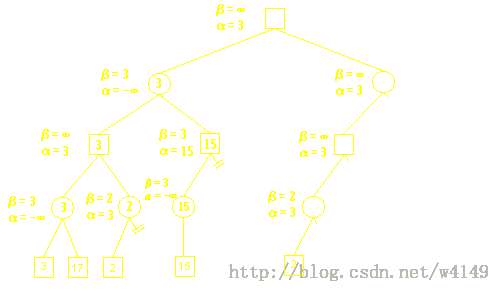POJ 1085 Triangle War 博弈 (对抗搜索 alpha-beta 剪枝)
Triangle War
Description
Triangle War is a two-player game played on the following triangular grid:
Two players, A and B, take turns filling in any dotted line connecting two dots, with A starting first. Once a line is filled, it cannot be filled again. If the line filled by a player completes one or more triangles, she owns the completed triangles and she is awarded another turn (i.e. the opponent skips a turn). The game ends after all dotted lines are filled in, and the player with the most triangles wins the game. The difference in the number of triangles owned by the two players is not important.
For example, if A fills in the line between 2 and 5 in the partial game on the left below:
Then, she owns the triangle labelled A and takes another turn to fill in the line between 3 and 5. B can now own 3 triangles (if he wishes) by filling in the line between 2 and 3, then the one between 5 and 6, and finally the one between 6 and 9. B would then make one more move before it is A’s turn again.
In this problem, you are given a number of moves that have already been made. From the partial game, you should determine which player will win assuming that each player plays a perfect game from that point on. That is, assume that each player always chooses the play that leads to the best possible outcome for himself/herself.
Input
You will be given a number of games in the input. The first line of input is a positive integer indicating the number of games to follow. Each game starts with an integer 6 <= m <= 18 indicating the number of moves that have been made in the game. The next m lines indicate the moves made by the two players in order, each of the form i j (with i < j) indicating that the line between i and j is filled in that move. You may assume that all given moves are legal.
Output
For each game, print the game number and the result on one line as shown below. If A wins, print the sentence “A wins.” If B wins, print “B wins.”
Sample Input
4
6
2 4
4 5
5 9
3 6
2 5
3 5
7
2 4
4 5
5 9
3 6
2 5
3 5
7 8
6
1 2
2 3
1 3
2 4
2 5
4 5
10
1 2
2 5
3 6
5 8
4 7
6 10
2 4
4 5
4 8
7 8
Sample Output
Game 1: B wins.
Game 2: A wins.
Game 3: A wins.
Game 4: B wins.
题意:
游戏有A、B两人参与。A先走,每人每次任选一条虚线填成实线。而如果某人填完一条线段后,该线段与另外两条相邻的实线组成了一个单位三角形,该三角形被标记为该游戏者所有,且该游戏者必须接着再填一条虚线。当18条线段被填充完毕后,拥有三角形多的玩家获胜。
首先输入一个数 T ,表示试验次数;接着一个数 n,表示当前局面已经走了 n 条边;接着输入 n 对数,每对数字表示一条填充边,由 A 开始。问从给出的局面开始,双方都采取最优策略,最终谁会取胜。
思路:
博弈问题, alpha-beta 搜索算法的应用。
#include
#include
#include
#include
#include 1) ? cb : ca); //没有新的三角形,
if(ta == ca && tb == cb)
cnt++;
}
int ans;
if(cnt & 1) ans = MinSearch(state, -1, ca, cb);
else ans = MaxSearch(state, 1, ca, cb);
printf("Game %d: %c wins.\n", ++cas, ans == 1 ? 'A' : 'B');
}
return 0;
} 转载一篇blog
感觉写的很清晰%%%
Alpha-Beta剪枝算法(Alpha Beta Pruning)
[说明] 本文基于<>,文中的图片均来源于此笔记。
Alpha-Beta剪枝用于裁剪搜索树中没有意义的不需要搜索的树枝,以提高运算速度。
假设α为下界,β为上界,对于α ≤ N ≤ β:
若 α ≤ β 则N有解。
若 α > β 则N无解。







